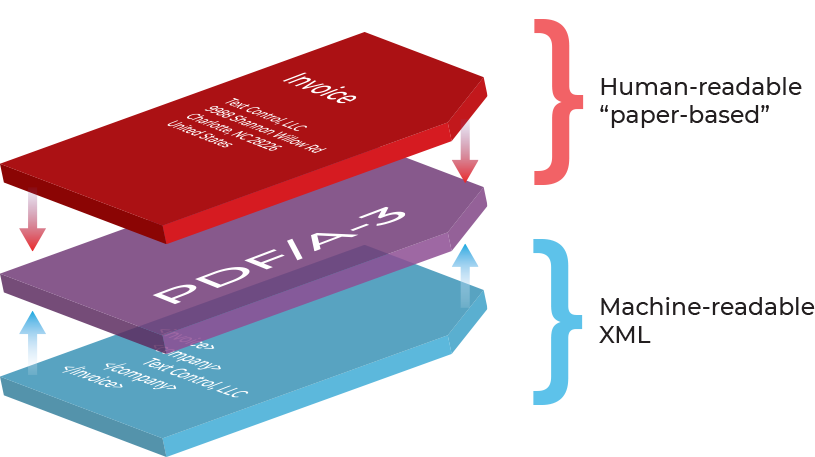Why PDF/UA and PDF/A-3a Matter: Accessibility, Archiving, and Legal Compliance
It is more important than ever to ensure that documents are accessible, archivable, and legally compliant. PDF/UA and PDF/A-3a are two effective standards for addressing these needs. This article explains why these standards are important and how they benefit organizations and individuals.

Business processes are increasingly dependent on digital documents; simply creating a PDF is no longer sufficient. To ensure long-term preservation and equitable access for all, including people with disabilities, two related yet distinct standards are essential: PDF/UA for accessibility and PDF/A-3a for archiving and embedded content.
This article explains what these standards are, why they matter (technically, legally, and ethically) what features a PDF must have to meet them, and how legal frameworks in the U.S. and Europe are promoting their adoption.
At a High Level: Accessibility vs Archiving
Before diving into standards, it helps to see where they overlap. It also helps to see where they differ.
- PDF/UA (Universal Accessibility) ensures that PDF content can be used by people with disabilities. For example, it can be accessed via screen readers, keyboard navigation, or other assistive technologies. PDF/UA establishes rules for tagging, structure, and metadata so that a document is semantically navigable, not just visually correct.
- PDF/A (PDF for archiving) ensures that a PDF is self-contained and can be reproduced reliably over the long term (years or decades). This involves embedding fonts, preventing external dependencies (e.g., external resources or active scripting), and ensuring color accuracy.
- PDF/A-3a is a version of PDF/A-3 that includes accessibility and structural requirements in addition to archiving requirements. In effect, it aims to provide the "best of both worlds": A PDF that is both archivable and accessible.
Due to this overlap, many organizations strive for dual conformance, creating PDFs that satisfy the requirements of both PDF/UA and PDF/A-3a.
Why These Standards Matter
PDF/UA compliance is more than a nice to have as it helps reduce legal risk and shows a commitment to inclusion. Accessibility ensures equal access to information for people with disabilities, and inaccessible documents exclude them from that right.
Many countries now require public facing documents in areas like government, healthcare, law and education to be accessible with penalties for noncompliance.
Both public and private organizations, especially in the United States and Europe, must increasingly meet accessibility standards to comply with laws and maintain contracts.
Long-Term Preservation
The PDF you create today may need to be readable 20, 50, or even 100 years from now. If it depends on external fonts, image references, scripting, or proprietary features, you may lose fidelity, or you may not be able to open the document at all.
PDF/A ensures that all necessary resources are included and that the document will render consistently across systems. It also ensures that the document will remain usable and trustworthy in long-term archives.
Embedding Source Files / E-invoicing / Data Interoperability
One distinguishing feature of PDF/A-3 (and, consequently, PDF/A-3a) is its ability to embed arbitrary file formats (e.g., Excel, XML, and CAD) as attachments within a PDF.
Learn More
This article shows how to create ZUGFeRD 2.3 compliant invoices using TX Text Control .NET Server. ZUGFeRD 2.3 is the latest version of the ZUGFeRD data model and complies with the European standard EN 16931. The article shows how to create ZUGFeRD 2.3 invoices and how to embed the XML invoice data in a PDF document.
Creating ZUGFeRD 2.3 (XRechnung, Factur-X) Documents with .NET C#
This enables you to distribute a human-readable and archivable PDF while also including the machine-readable source (e.g., XML invoice data) with it. This is useful in legal, financial, regulatory, and archival contexts.

However, from an archival point of view, embedding arbitrary files does come with risks (e.g., if the embedded format becomes obsolete).
Legal & Regulatory Landscape: U.S. and Europe
Both the United States and Europe have enacted laws and regulations that promote or require the use of accessible, archivable documents.
Section 508 / Rehabilitation Act
- According to Section 508 (29 U.S.C. § 794d), federal agencies must ensure that their electronic and information technology (EIT) is accessible to people with disabilities.
- In 2017, the U.S. Access Board issued a final rule updating the Section 508 standards to align them more closely with the Web Content Accessibility Guidelines (WCAG) 2.0.
- According to the updated standards, PDFs used by federal agencies must adhere to the relevant accessibility criteria, which are closely tied to the principles of PDF/UA.
- While Section 508 isn't always enforced across all sectors, any contractor, grantee, or entity interacting with the federal government is typically required to meet these standards.
Americans with Disabilities Act (ADA)
- The ADA does not explicitly mention PDFs, but it requires places of public accommodation and commercial entities to provide accessible communication and information.
- Courts have increasingly interpreted the ADA to include website and digital content accessibility as part of communication obligations. Therefore, inaccessible PDFs on a public-facing website may subject an organization to ADA-based lawsuits.
European Accessibility Act (EAA)
- Effective June 2025, the EAA will set harmonized accessibility requirements for many digital products and services across the EU, including "digital documents."
- The EAA utilizes EN 301 549, the EU standard for ICT accessibility, and essentially requires conformity with WCAG/accessible document standards.
- The EAA applies to even non-EU companies providing services to the EU.
- While the EAA doesn't explicitly mention "PDF/UA," many entities adopt PDF/UA or equivalent standards to satisfy the requirement for accessible "documents."
- The European Web Accessibility Directive already required accessible PDFs and content for public sector websites and apps, and the EAA extends this requirement to the private sector.
- In Germany, for example, court rulings have determined that public documents (e.g., those in the healthcare sector) must be accessible in PDF form by 2025.
For many organizations in Europe, accessible PDFs are no longer optional. They are part of compliance with EU-wide and national regulations.
What to Expect in TX Text Control 34.0
The upcoming version 34.0 adds powerful features to improve document accessibility, including:
- Generation of fully tagged PDFs
- Compliance with the PDF/A-3a and PDF/UA standards
- Semantic tagging for elements such as headings, paragraphs, tables, and lists
- Alternative text descriptions for images
- Support for logical reading order
All TX Text Control editions and platforms will include these capabilities, allowing developers to create fully accessible documents directly within their web applications.
Why Tagged PDFs Benefit AI and Automation
Most PDFs only represent visual layouts-text and graphics positioned on a page without semantic meaning. Tagged PDFs, however, include structural information that helps artificial intelligence, automation systems, and machine learning models interpret and process document content more intelligently.
Learn More
We are happy to announce that version 34.0 will support PDF/UA compliance and the creation of tagged PDF documents. This significant update demonstrates our ongoing commitment to accessibility by enabling the creation of fully accessible documents that comply with modern standards for users with assistive technologies.
Upcoming Support for PDF/UA Compliance and Tagged PDF Generation in Version 34.0
Conclusion
As digital documents become central to business and communication, it is crucial to ensure that they are accessible and archivable. The PDF/UA and PDF/A-3a standards promote inclusivity and long-term preservation, addressing these needs.
Legal frameworks in the U.S. and Europe are driving the adoption of these standards, making compliance a legal and ethical imperative, not just a technical requirement. By embracing these standards, organizations can enhance accessibility, ensure long-term usability, and mitigate legal risks.
With TX Text Control 34.0, developers can easily create documents that meet these important standards, helping to build a more inclusive and sustainable digital future.
ASP.NET
Integrate document processing into your applications to create documents such as PDFs and MS Word documents, including client-side document editing, viewing, and electronic signatures.
- Angular
- Blazor
- React
- JavaScript
- ASP.NET MVC, ASP.NET Core, and WebForms
Related Posts
Validate Digital Signatures and the Integrity of PDF Documents in C# .NET
Learn how to validate digital signatures and the integrity of PDF documents using the PDF Validation component from TX Text Control in C# .NET. Ensure the authenticity and compliance of your…
Validate PDF/UA Documents and Verify Electronic Signatures in C# .NET
The new TXTextControl.PDF.Validation NuGet package enables you to validate PDF/UA documents and verify digital signatures directly in your code without relying on third-party tools or external…
Automating PDF/UA Accessibility with AI: Describing DOCX Documents Using TX…
This article shows how to use TX Text Control together with the OpenAI API to automatically add descriptive texts (alt text and labels) to images, links, and tables in a DOCX. The resulting…
How To Choose the Right C# PDF Generation Library: Developer Checklist
To make your choice easy, this guide provides a systematic evaluation framework for two library categories: basic and enterprise PDF libraries. It covers matching features to use cases, evaluating…
Introducing TX Text Control 34.0: Your Next Leap in Document Processing.
We are happy to announce the release of TX Text Control 34.0. This version is packed with new features and enhancements that will elevate your document processing experience. This version…






